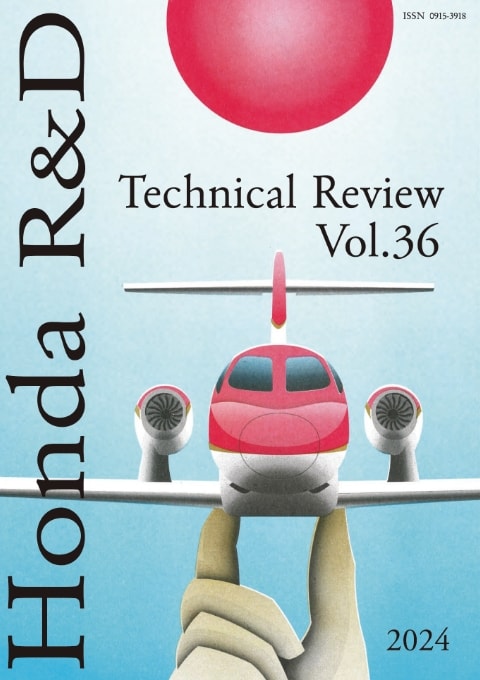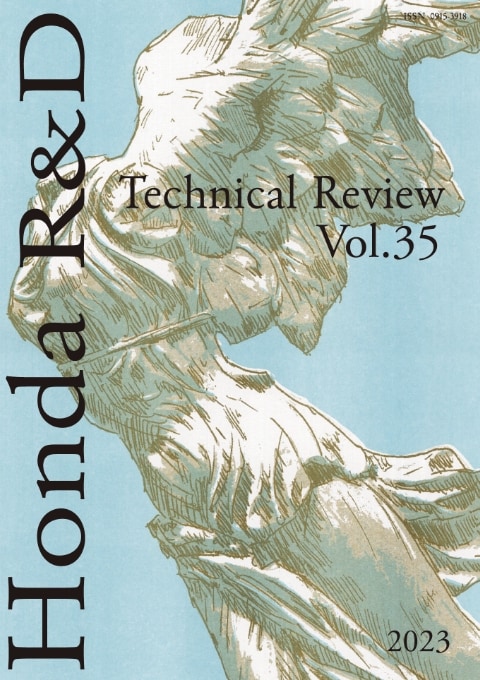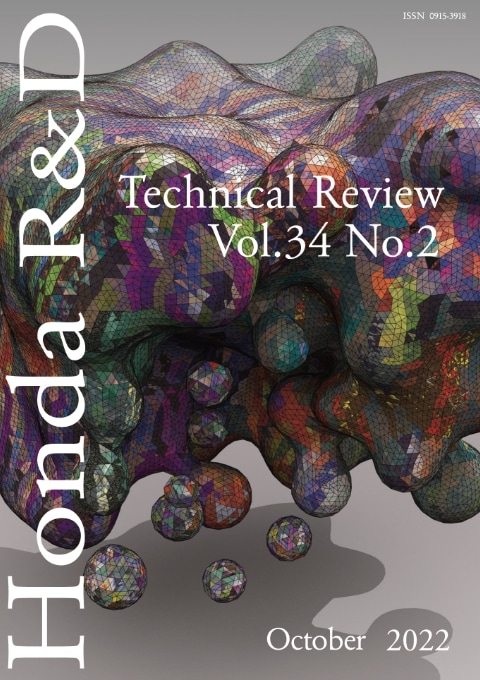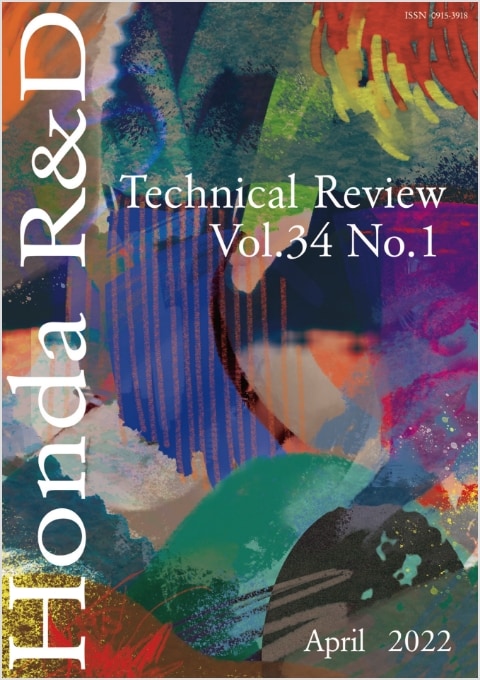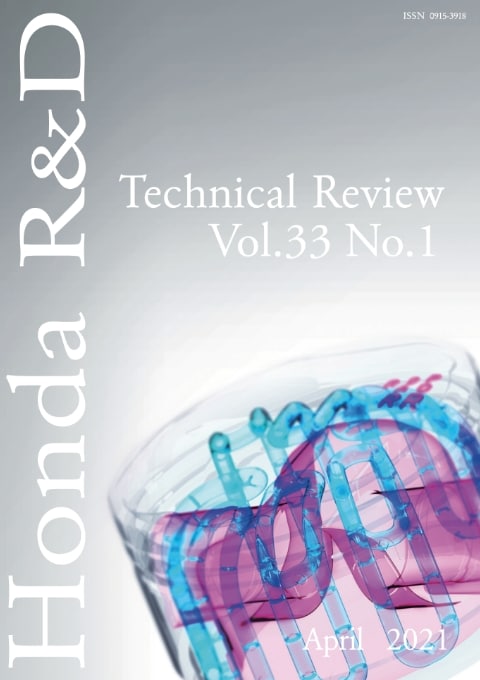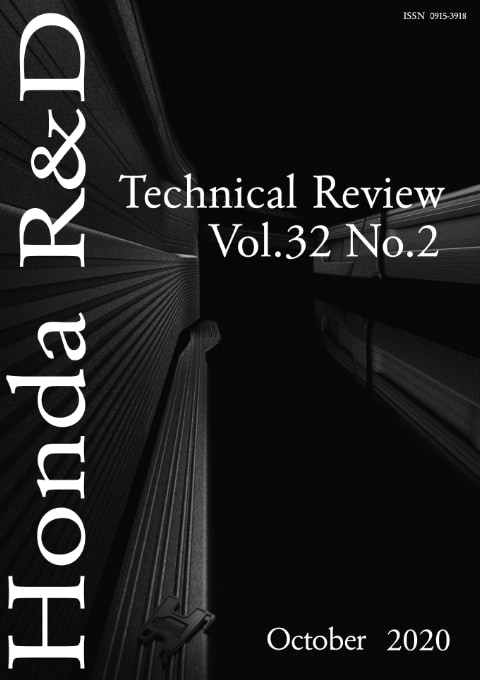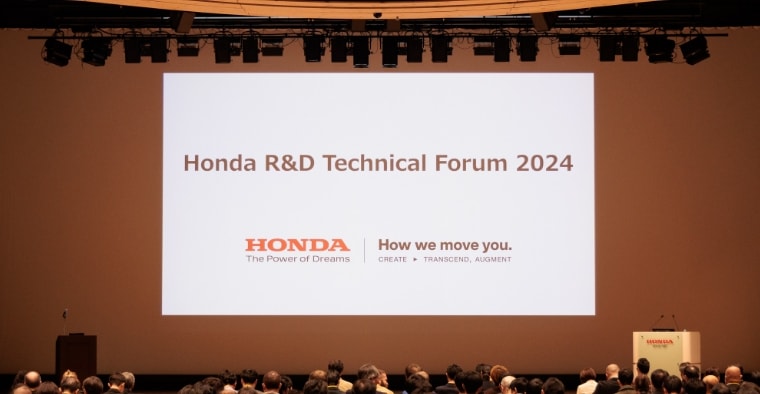Honda R&D Technical Review Vol.33 No.2
Honda R&D
Technical Review Vol.33 No.2
- Design Development of Honda e - Vehicle Conveying Concepts of Modern Technology and Affinity
- Summary
The Honda e was developed to be the best compact-size commuter car for in-town mobility, and is Honda’s first mass-production electric vehicle. Looking 10 years into the future, the aim was to create a car that would be like a partner that fits closely into the user’s everyday life in a world where advanced modern technology seamlessly connects with people.
In giving the design its material form, the expression “Affinity & Modern” served as keywords. The aim for the package was a comprehensive effort to realize the best size for in-town mobility. For the exterior, the design plumbed the depths of simplicity to achieve a stable automotive stance together with distinctive body colors that highlight the styling. The interior expressed the comfort of a cozy living room with a feeling of high quality.Satoshi UCHIDA、Ken SAHARA、Akinori MYOI、Sayuri HANZAWA
Details of papers - Development of Ropot, Traffic Safety Advice Robot
- Summary
In Japan, seven-year-olds experience an exceptionally high number of pedestrian accidents. To address this, the authors developed a traffic safety advice robot, Ropot, to assist the teaching of traffic safety to children in the lower grades of elementary school.
Ropot has educational functions and receptive functions. In particular, three of the educational functions, known as “check point remind,” “backward check remind,” and “check point result review function,” have not been found in any other device up to now.
To develop these functions, the authors used a global navigation satellite system with high-precision positioning and millimeter wave radar with good environmental robustness. These functions are contained within a partner design that is appealing to children, which enhances the receptive functions.
At an educational trade fair and proving tests, children, their guardians, and school personnel responded positively to the educational and receptive functions, and the effectiveness of Ropot was confirmed.Tae KIKUCHI、Satoshi FUJII、Junya KUSUDO、Tomoya AMARI、Kuniharu WAKATA、Yu SAITSU
Details of papers - Short Lead Time Development of Customized Vehicles with Preventive Measures for COVID-19 Infection - Social Contribution through Swift Provision of Vehicles -
- Summary
Honda has developed a vehicle for transporting infected persons in order to support local governments and medical institutions responding to COVID-19. Honda first developed specifications to protect drivers from infection while transporting infected persons or persons suspected to be infected to medical institutions and the like, then incorporated the specifications into an existing production vehicle and delivered the infected person transport vehicle to local governments within two weeks. In order to develop and provide the vehicle in a short period of time, simple infection-prevention mechanisms were adopted. These consisted of a flat partition attached to the rear of the driver’s seat in the existing vehicle and the ventilation functions of the vehicle’s air conditioner. Infection prevention performance indices were the differential pressure between the spaces fore and aft of the partition and the cabin ventilation capacity. The differential pressure target of over 2.5 Pa (standard for medical operating room) and the cabin ventilation capacity target value of over 12 times/h were achieved. Between April and December of 2020, 158 of these vehicles were assembled and provided to 25 municipalities and prefectures.
Keiichiro NAKAO、Toshiyuki TANAKA
Details of papers - Unmanned Vehicle Transportation System Using Pair of Thin Robots
- Summary
An unmanned vehicle system that transports cars in place of humans was devised. To enable application to a wide range of vehicle types including those without automated driving functions, vehicle transportation robots that are not constrained by car body performance are used for vehicle transportation. Additionally, in order to transport vehicles even in limited indoor and urban spaces, the system employs a pair of robots that move freely underneath the target vehicle, lift up the tires of the vehicle at the same time, and cooperate to achieve free omni-directional transportation. A prototype of the vehicle transportation robot was developed to verify system feasibility. Operation verification experiments were conducted using the developed prototype in a limited space, and confirmed realization of the desired transport operation.
Shuhei KONDO、Koji MASUDA、Naoto SHIKANO、Tomoki MUROZONO
Details of papers - Simultaneous Reduction of NOx and Smoke by Divided Diffusion Combustion Using High Dispersion Staggered Layout Nozzle
- Summary
In order to realize extremely low emissions with diffusive diesel combustion, a study was made of methods for smoke suppression under the high-boost, high-EGR conditions that are effective in reducing NOx. Divided combustion that combines a reduction in the injected amount of main fuel with premixed combustion in which the amount of fuel injected early is increased was adopted in order to reduce the rich portion of the main diffusion combustion, which was the main generator of smoke in conventional combustion. The adoption of this divided combustion made it possible to raise the fuel injection pressure, which had previously been limited due to combustion noise, and a smoke reduction effect was confirmed together with the effect of divided combustion. In addition, a staggered spray layout was adopted in order to reduce dilution of the premixed injection. Combining these methods achieved diffusive diesel combustion with extremely low emissions, and reduced NOx by 40% while not causing increases in combustion noise or smoke, or reduction of thermal efficiency relative to conventional combustion.
Hirokazu ANDO、Satoshi AOYAGI、Masayuki NAKATSU、Naoki OHYA
Details of papers - Reproduction of Engine Torque Fluctuation with Low Inertia and High Stiffness Dynamometer
- Summary
The dynamometer used in a Virtual and Real Simulator was enhanced to increase the analysis efficiency of issues and events arising from engine torque fluctuation. The contribution of the dynamometer components was clarified using 1D CAE and structural changes were made to expand the reproducible frequency range. As a result, the reproducible torque fluctuation frequencies were expanded, and analysis could be performed using a Virtual and Real Simulator in the operating range where noise and vibration are issues in 4-cylinder and 6-cylinder engines. This bench system can be used to test analyses of mechanisms of drivetrain torsional vibration, such as rattle noise, arising from engine torque fluctuation, without recombining parts. This research can enhance the analysis efficiency of drivetrain torsional vibration issues arising from engine torque fluctuation and contribute to early determination of specifications.
Keiji SHIOTA、Masaki SAGAWA、Masafumi AMANO、Kazuyuki SUETAKE
Details of papers - Comprehensive Study of Solvents for Wet Process Applied to Sulfide-based All Solid State Battery
- Summary
In the process of creating a wet process for a sulfide-based all solid state battery, it was necessary to search for suitable solvents. A systematic examination was therefore made of solid electrolytes and the reactivity of solvents. A halogen-doped argyrodite solid electrolyte that shows high lithium-ionic conductivity did not react with a hydrocarbon compound containing no polar group. With ethers, esters, ketones, and nitriles, however, the oxygen atoms and nitrogen atoms in their respective polar groups interact strongly with the solid electrolyte and were expected to form complexes with the lithium ions in the electrolyte. However, solvents having an alkyl chain length with a carbon number of four were not found to form complexes and the ionic conductivity of the solid electrolyte had not been markedly diminished. This is thought to occur because the increase in length of alkyl chains decreases the surface area accessible to coordinating oxygen atoms in the solvent molecules, thereby inhibiting the approach of the solvent to the surface of the solid electrolyte. Setting the carbon number of four or greater for the alkyl group chain length as a solvent search index yielded a direction to pursue for practical application of a wet process.
Pu QIAN、Hiroshi SAKAI、Atsushi OGAWA、Hiroto MAEYAMA、Terumi FURUTA
Details of papers
- About Honda R&D
- Honda Philosophy
- Top Message
- Mission
- Organization
- Company Overview and Affiliates
- Members
- Award
- R&D Research Paper




